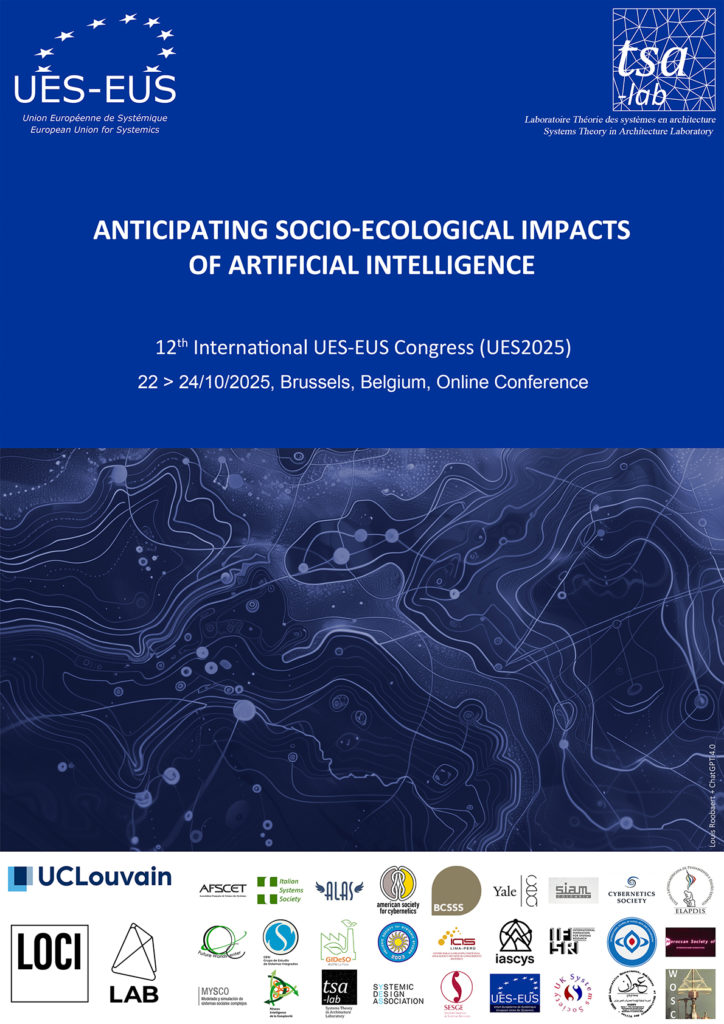Organisé par le Laboratoire théorie des systèmes en architecture (tsa-lab), Faculty of architecture, architectural engineering, town planning (LOCI), University of Louvain (UCLouvain)
En ligne, Bruxelles, Belgique, 22-24/10/2025
https://www.ues-eus.org/2025/index.html
Avec les interventions de:
Claire Bailly and Jean Magerand : « AI as a Catalyst for Systemic Creativity: Toward a New Urban Design Epistemology »
Jean Magerand and Claire Bailly : « Complex Art and Agronomy »
Title: AI as a catalyst for systemic creativity: toward a new urban design epistemology
Authors: Jean Magerand (ENSAPVS); Claire Bailly (EVCAU)*
Contact: iphonecbailly@gmail.com
Abstract: In light of contemporary challenges related to socio-ecological transition and the emergence of
artificial intelligence, the aim is to develop a project-based culture that enables thinking and acting (Lemoigne)
within complex, uncertain, and evolving environments, by mobilizing a systemic and transdisciplinary approach.
The central objective is to integrate key concepts from complexity sciences (Morin), while considering digital
technologies and AI as levers for experimenting with new forms of creavvity, organization and collective
intelligence. Insights from constructivist epistemologies applied to digital humanives (Drucker) also play a
central role in this approach. The design studio « Natural Encodings, Digital Decodings, and Urban Processes »
(ENSA Paris-Val de Seine) proposes a methodological re-foundation of architectural and urban pedagogy. It
combines contribuvons from scientific ecology, biology and living systems, complex systems thinking and digital
tools. The pedagogy is part of an ecosystem of methods where design protocols based on experimentation
interact with academic knowledge production, hypothesis formulation, and implementation of generative
approaches. AI is introduced through algorithmic processes as exploratory tools for combinatory,
transformational, or self-organizing creavvity. Mulvagent systems, cellular automata, and their underlying
methods help embed complex notions such as selforganization, emergence, dynamic equilibrium or
organizational noise into the design process. The presentation will draw on the example of an urban design
project that reimagines the urban digital twin through the lens of complexity. This teaching framework reveal a
significant evolution in students’ representations and pracvces: the resulting projects reflect an improved
understanding of socio-ecological dynamics and an enhanced ability to integrate feedback, uncertainty, and
transformavon into the design process. A crivcal use of AI allows for deeper questioning of notions such as
resilience, co-evoluvon, and the hybridization of living and arvficial systems. This pedagogical approach offers a
concrete alternative to technocentric perspectives on AI by embedding it within a systemic research-creation
framework.
Keywords: Constructivist Epistemology, AI, Design
Title : Complex Art and Agronomy
Authors: Jean Magerand (ENSAPVS); Claire Bailly (EVCAU)
Contact: jean.magerand.archi@gmail.com
Abstract: The Bio-Digital Movement explores complex invention processes grounded in transdisciplinarity. It
interweaves research approaches, project development, and experimental exploration. This movement
generates complex territorial and/or constructive organizations that are in harmony and synergy with the
complexity of natural environments. To design the complex territory of the bio-digital permaculture Macro-
Farm (selected for the 2025 Innovation Awards), the inventive process is based on algorithmics. Drawing from
complex natural generative modes, it creates complex artificial generative systems. This design approach relies
on transdisciplinarity, supported by artificial intelligence, and aims to generate agro-ecologicaleconomic modes
of organization. To enrich this complex inventive process, it is paired with a bio-digital artistic approach, also
founded on algorithmics inspired by natural genetics. This hybrid method extracts algorithms from selected
artificial and natural objects, chosen by designers based on artistic-conceptual criteria. Agronomic and artistic
algorithms are then hybridized. This fusion leads to new material and immaterial artworks and generates
evolving ensembles of creations. Agriculture thus becomes a large-scale productive artwork—a complex
invented landscape. The Macro-Farm also integrates user-consumer-producer consultation directly into the
inventive process. Through algorithmic approaches, links are forged between technical invention, artistic
creation and human management. The farm manages dynamic balances, self-organization, negentropy,
resilience and sustainability in service of durable productivity. Thanks to AI, its organization is captured and
memorized. It can be reproduced, improved, and convnuously enhanced. By integravng artisvc pracvce into
technical invenvon, unique aesthevc identity is cultivated. Finally, the invention of a governance model adapted
to the socio-geographic context is an integral part of the invenvve system. The algorithmic properves of
complex human organizations (urban, architectural, agronomic, social) enable the connecvon of arvficial
intelligence with generavve modes and complex inventive processes. The goal is to develop high-complexity
socio-agronomic-economic meta-organizations that benefit natural environments, local development, users,
and the emergence of new artistic sensibilities.
Keywords: Art, Permaculture, Algorithmics
Keywords: Art, Permaculture, Algorithmics





